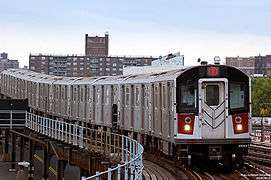Parkchester (IRT Pelham Line)
| Parkchester | |||||||||||
|---|---|---|---|---|---|---|---|---|---|---|---|
| New York City Subway rapid transit station | |||||||||||
_by_David_Shankbone.jpg) | |||||||||||
| Station statistics | |||||||||||
| Address |
area of Cross-Bronx Expressway, Metropolitan Avenue & Westchester Avenue Bronx, NY 10472 | ||||||||||
| Borough | The Bronx | ||||||||||
| Locale | Parkchester | ||||||||||
| Coordinates | 40°50′0″N 73°51′39.5″W / 40.83333°N 73.860972°WCoordinates: 40°50′0″N 73°51′39.5″W / 40.83333°N 73.860972°W | ||||||||||
| Division | A (IRT) | ||||||||||
| Line | IRT Pelham Line | ||||||||||
| Services |
6 | ||||||||||
| Transit connections |
| ||||||||||
| Structure | Elevated | ||||||||||
| Platforms |
2 island platforms cross-platform interchange | ||||||||||
| Tracks | 3 | ||||||||||
| Other information | |||||||||||
| Opened | May 27, 1920[1] | ||||||||||
| Former/other names |
Parkchester–East 177th Street East 177th Street–Parkchester East 177th Street | ||||||||||
| Traffic | |||||||||||
| Passengers (2015) |
5,224,959[2] | ||||||||||
| Rank | 90 out of 422 | ||||||||||
| Station succession | |||||||||||
| Next north |
Castle Hill Avenue (local): 6 Pelham Bay Park (express): no regular service (Terminal): 6 | ||||||||||
| Next south |
St. Lawrence Avenue (local): 6 Hunts Point Avenue (express): <6> | ||||||||||
| |||||||||||
| |||||||||||
Parkchester (formerly known as and still announced as Parkchester–East 177th Street) is an express station on the IRT Pelham Line of the New York City Subway. The station opened on May 27, 1920.[1] It is located in the Bronx at the intersection of the Cross-Bronx Expressway service roads (formerly East 177th Street), Metropolitan Avenue, and Westchester Avenue, atop Hugh J. Grant Circle. It is served by the 6 train at all times and the <6> train during weekdays in the peak direction. By passenger count, Parkchester is the third busiest station in the Bronx in 2014, behind 161st Street–Yankee Stadium and Third Avenue–149th Street, which are respectively the busiest and second busiest stations.
Station layout
| P Platform level |
Southbound local | ← |
| Peak-direction express | ← → (No service: Pelham Bay Park) → | |
| Northbound local | → → | |
| M | Mezzanine | Station agent, MetroCard vending machines, fare control |
| G | Street Level | Exit/Entrance |
Parkchester is an express station with three tracks and two island platforms. There are 1950s-style mushroom-shaped lights at the end of the platforms and the staircases to the mezzanine are sheltered. The mezzanine has a crossunder and windows in a simulated 12-pane pattern similar to those at Whitlock Avenue. The fare control is at street level and the room features a painting entitled Live The Dream. There is an escalator from fare control to the southbound platform, bypassing the mezzanine. Just north of the station is a signal tower which was used until the late 1990s, when a new master tower was created in Westchester Yard.
When <6> express trains operate, 6 local trains terminate here. <6> express trains always stop on the center track and 6 local trains always stop on the outer track, even when they terminate there. Trains use the switches north of the station to get to their respective track. Terminating trains use the center track past those switches as a pocket track to relay.
The IRT Pelham Line north of this station is served by a local train at all times except rush hours when <6> trains make local stops between this station and Pelham Bay Park. During this time, trains switch designations at Pelham Bay Park for the return trip to Manhattan.
This station was rehabilitated in 2010.
Image gallery
 Entrance to Parkchester station
Entrance to Parkchester station The lampposts at the station, which still read "E 177 ST"
The lampposts at the station, which still read "E 177 ST" Snow on the platform
Snow on the platform A R142A train approaching Parkchester
A R142A train approaching Parkchester
References
- 1 2 "Bronx Subway Extension Opened". New York Times. May 28, 1920. Retrieved 25 January 2016.
- ↑ "Facts and Figures: Annual Subway Ridership". Metropolitan Transportation Authority. Retrieved 2016-04-19.
External links
| Wikimedia Commons has media related to Parkchester (IRT Pelham Line). |
- nycsubway.org – IRT Pelham Line: East 177th Street/Parkchester
- nycsubway.org — Live the Dream Artwork (Artist and date unknown)
- Station Reporter — 6 Train
- Map of Bronx Subways
- The Subway Nut — Parkchester – East 177th Street Pictures
- Hugh Grant Circle (west) entrance from Google Maps Street View
- Hugh Grant Circle (east) entrance from Google Maps Street View



